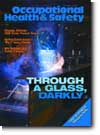
October 2005
Cover Story
By Ronnie Rittenberry
THE technology available in today's auto-darkening welding helmets was the stuff of science fiction to welders 30 years ago. A single lens capable of darkening automatically to a variable, preset shade level the instant an arc is struck would have sounded about as realistic as a "Star Trek"-style "transporter" or a cell phone that can take pictures.
Features
By David Fritzsche, Drew Myklegard
AUTOMATED external defibrillators are becoming increasingly common in workplaces and public facilities across the nation.
By Stephanie M. Pendergrass, Dr. Donald D. Dollberg
THE National Institute for Occupational Safety and Health publishes the NIOSH Manual of Analytical Methods (NMAM), a primary reference that has been a reliable source of analytical methods used in occupational health laboratories throughout the world for more than 25 years.
By Casey Hayes
ONE doesn't normally think about water conservation during an emergency. A fire, for example, needs to be contained and extinguished as quickly as possible. And that usually means using copious amounts of water.
By Jerry Laws
LIKE a lot of us, the people who routinely cut open boxes in stores, restaurants, warehouses, and health care facilities are creatures of habit. Many of them don't welcome a new cutting tool.
By Rebecca Geissler
AS long as people have been heading to the workplace, there have been workplace accidents. According to OSHA, some 4 million non-fatal injuries and illnesses occur each year in workplaces across the United States, which is why it is essential for facilities with potential hazards to provide the right emergency fixtures as protection against serious injury or fatalities.
By Bill Smith
MANKIND has continuously searched for and found evolving means for survival. Gas monitoring instrumentation has been a part of that evolution. In the span of the last 200+ years, the act of monitoring a worker's environment for explosive and toxic gases, as well as for oxygen enrichment or deficiency, has seen a tremendous evolution.
By Larry Garner
IT was a normal work day for J.D. Buske. With the blink of an eye, all of that changed. He almost became one of the one thousand daily eye injury statistics reported in the United States. Here's his story: "Hello, my name is J.D., and I live in San Antonio, Texas. Today your product saved my right eye and prevented me from serious injury to my face. Let me explain what happened.
By Ted Christensen
TRUE, the construction industry's disabling injury rate is steadily declining, but there is still room for improvement. Providing a safe work environment is the right thing to do and requires focusing on and developing practical safety program elements to address the causes of disabling injury.
By Larry Wilson
OF course, we're not talking about your training sessions. And we're not talking about mine, either. It's those other guys--it's their safety training sessions we're talking about.
Departments
By Jerry Laws
BY the time you read this, the final ASIS International Workplace Violence Prevention and Response Guideline should be printed and available free online.
"A few years ago, this type of artificial intelligence-based fire detection just simply was technically impossible in real time."
By Ronnie Rittenberry
Editor's note: Early warning is everything when it comes to fires, say the developers of SigniFireTM, a software system that uses patented image-analysis technology designed for instant fire, smoke, and intrusion detection.